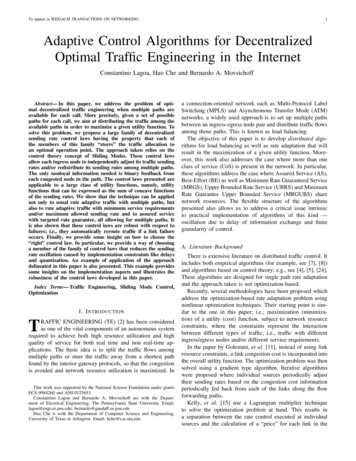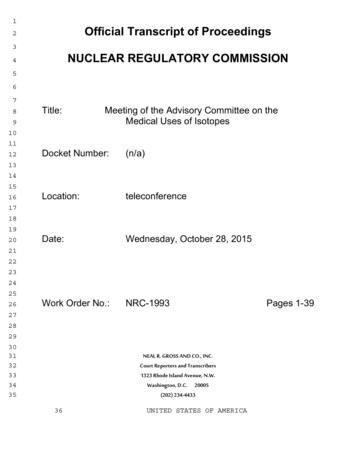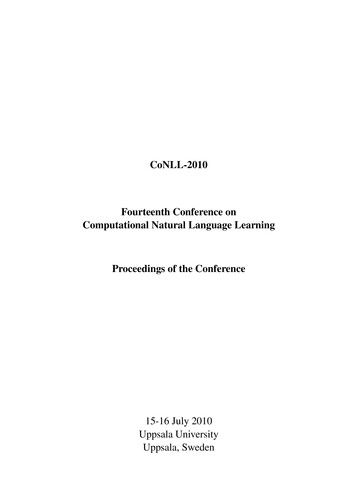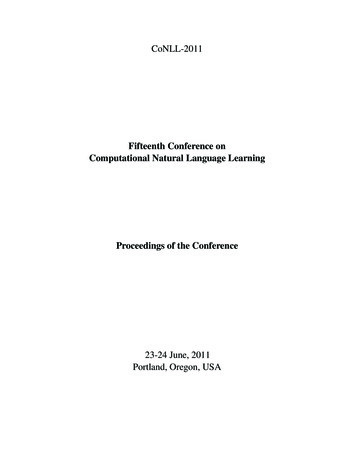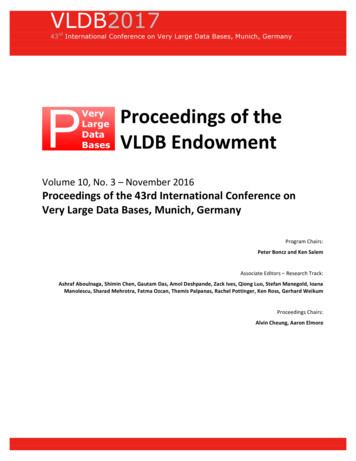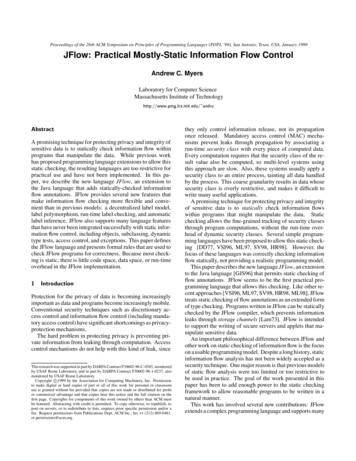
Transcription
Proceedings of the 26th ACM Symposium on Principles of Programming Languages (POPL ’99), San Antonio, Texas, USA, January 1999JFlow: Practical Mostly-Static Information Flow ControlAndrew C. MyersLaboratory for Computer ScienceMassachusetts Institute of Technologyhttp://www.pmg.lcs.mit.edu/ andruAbstractA promising technique for protecting privacy and integrity ofsensitive data is to statically check information flow withinprograms that manipulate the data. While previous workhas proposed programming language extensions to allow thisstatic checking, the resulting languages are too restrictive forpractical use and have not been implemented. In this paper, we describe the new language JFlow, an extension tothe Java language that adds statically-checked informationflow annotations. JFlow provides several new features thatmake information flow checking more flexible and convenient than in previous models: a decentralized label model,label polymorphism, run-time label checking, and automaticlabel inference. JFlow also supports many language featuresthat have never been integrated successfully with static information flow control, including objects, subclassing, dynamictype tests, access control, and exceptions. This paper definesthe JFlow language and presents formal rules that are used tocheck JFlow programs for correctness. Because most checking is static, there is little code space, data space, or run-timeoverhead in the JFlow implementation.1 IntroductionProtection for the privacy of data is becoming increasinglyimportant as data and programs become increasingly mobile.Conventional security techniques such as discretionary access control and information flow control (including mandatory access control) have significant shortcomings as privacyprotection mechanisms.The hard problem in protecting privacy is preventing private information from leaking through computation. Accesscontrol mechanisms do not help with this kind of leak, sinceThis research was supported in part by DARPA Contract F30602-96-C-0303, monitoredby USAF Rome Laboratory, and in part by DARPA Contract F30602-98-1-0237, alsomonitored by USAF Rome Laboratory.Copyright c 1999 by the Association for Computing Machinery, Inc. Permissionto make digital or hard copies of part or all of this work for personal or classroomuse is granted without fee provided that copies are not made or distributed for profitor commercial advantage and that copies bear this notice and the full citation on thefirst page. Copyrights for components of this work owned by others than ACM mustbe honored. Abstracting with credit is permitted. To copy otherwise, to republish, topost on servers, or to redistribute to lists, requires prior specific permission and/or afee. Request permissions from Publications Dept, ACM Inc., fax 1 (212) 869-0481,or permissions@acm.org.they only control information release, not its propagationonce released. Mandatory access control (MAC) mechanisms prevent leaks through propagation by associating arun-time security class with every piece of computed data.Every computation requires that the security class of the result value also be computed, so multi-level systems usingthis approach are slow. Also, these systems usually apply asecurity class to an entire process, tainting all data handledby the process. This coarse granularity results in data whosesecurity class is overly restrictive, and makes it difficult towrite many useful applications.A promising technique for protecting privacy and integrityof sensitive data is to statically check information flowswithin programs that might manipulate the data. Staticchecking allows the fine-grained tracking of security classesthrough program computations, without the run-time overhead of dynamic security classes. Several simple programming languages have been proposed to allow this static checking [DD77, VSI96, ML97, SV98, HR98]. However, thefocus of these languages was correctly checking informationflow statically, not providing a realistic programming model.This paper describes the new language JFlow, an extensionto the Java language [GJS96] that permits static checking offlow annotations. JFlow seems to be the first practical programming language that allows this checking. Like other recent approaches [VSI96, ML97, SV98, HR98, ML98], JFlowtreats static checking of flow annotations as an extended formof type checking. Programs written in JFlow can be staticallychecked by the JFlow compiler, which prevents informationleaks through storage channels [Lam73]. JFlow is intendedto support the writing of secure servers and applets that manipulate sensitive data.An important philosophical difference between JFlow andother work on static checking of information flow is the focuson a usable programming model. Despite a long history, staticinformation flow analysis has not been widely accepted as asecurity technique. One major reason is that previous modelsof static flow analysis were too limited or too restrictive tobe used in practice. The goal of the work presented in thispaper has been to add enough power to the static checkingframework to allow reasonable programs to be written in anatural manner.This work has involved several new contributions: JFlowextends a complex programming language and supports many
2.1 Labelslanguage features that have not been previously integratedwith static flow checking, including mutable objects (whichsubsume function values), subclassing, dynamic type tests,and exceptions. JFlow also provides powerful new featuresthat make information flow checking less restrictive and moreconvenient than in previous programming languages:In the decentralized label model, data values are labeledwith security policies. A label is a generalization of theusual notion of a security class; it is a set of policies thatrestrict the movement of any data value to which the labelis attached. Each policy in a label has an owner O, whichis a principal whose data was observed in order to create thevalue. Principals are users and other authority entities suchas groups or roles. Each policy also has a set of readers,which are principals that O allows to observe the data. Asingle principal may be the owner of multiple policies andmay appear in multiple reader sets.For example, the label L f o1 : r1 , r2 ; o2 : r2 , r3 g has twopolicies in it (separated by semicolons), owned by o 1 and o2respectively. The policy of principal o 1 allows r1 and r2 toread; the policy of principal o 2 allows r2 and r3 to read. Theeffective reader set contains only the common reader r2 . Theleast restrictive label possible is the label fg, which containsno policies. Because no principal expresses a privacy interestin this label, data labeled by fg is completely public as far asthe labeling scheme is concerned.There are two important intuitions behind this model: first,data may only be read by a user of the system if all of thepolicies on the data list that user as a reader. The effectivepolicy is an intersection of all the policies on the data. Second,a principal may choose to relax a policy that it owns. Thisis a safe form of declassification — safe, because all of theother policies on the data are still enforced.A process has the authority to act on behalf of some (possibly empty) set of principals. The authority possessed bya process determines the declassifications that it is able toperform. Some principals are also authorized to act for otherprincipals, creating a principal hierarchy. The principal hierarchy may change over time, but revocation is assumed tooccur infrequently. The meaning of a label is affected by thecurrent principal hierarchy. For example, if the principal r 0can act for the principal r, then if r is listed as a reader bya policy, r 0 is effectively listed by that policy as well. Themeaning of a label under different principal hierarchies isdiscussed extensively in an earlier paper [ML98].Every variable is statically bound to a static label. (Thealternative, dynamic binding, largely prevents static analysisand can be simulated in JFlow if needed.) If a value v has labelL1 and a variable x has label L2 , we can assign the value tothe variable (x : v ) only if L1 can be relabeled to L2 , whichis written as L1 v L2 . The definition of this binary relationon labels is intuitive: L1 v L2 if for every policy in L 1 , thereis some policy in L2 that is at least as restrictive [ML98].Thus, the assignment does not leak information.In this system, the label on x is assigned by the programmerwho writes the code that uses x. The power to select a labelfor x does not give the programmer the ability to leak v ,because the static checker permits the assignment to x only ifthe label on x is sufficiently restrictive. After the assignment,the static binding of the label of x prevents leakage. (Changesin who can read the value in x are effected by modifying theprincipal hierarchy, but changes to the principal hierarchyrequire appropriate privilege.) It supports the decentralized label model [ML97,ML98], which allows multiple principals to protect theirprivacy even in the presence of mutual distrust. Italso supports safe, statically-checked declassification,or downgrading, allowing a principal to relax its ownprivacy policies without weakening policies of otherprincipals. It provides a simple but powerful model of access control that allows code privileges to be checked statically,and also allows authority to be granted and checkeddynamically. It provides label polymorphism, allowing code that isgeneric with respect to the security class of the data itmanipulates. Run-time label checking and first-class label values provide a dynamic escape when static checking is too restrictive. Run-time checks are statically checked to ensure that information is not leaked by the success orfailure of the run-time check itself. Automatic label inference makes it unnecessary to writemany of the annotations that would otherwise be required.The JFlow compiler is structured as a source-to-sourcetranslator, so its output is a standard Java program that canbe compiled by any Java compiler. For the most part, translation involves removal of the static annotations in the JFlowprogram (after checking them, of course). There is littlecode space, data space, or run time overhead, because mostchecking is performed statically.The remainder of this paper is structured as follows: Section 2 contains an overview of the JFlow language and arationale for the decisions taken. Section 3 discusses staticchecking, sketches the framework used to check programconstructs in a manner similar to type checking, and both formally and informally presents some of the rules used. Thissection also describes the translations that are performed bythe compiler. Section 4 compares this work to other work inrelated areas, and Section 5 provides some conclusions. Thegrammar of JFlow is provided for reference in Appendix A.2 Language overviewThis section presents an overview of the JFlow language anda rationale for its design. JFlow is an extension to the Javalanguage that incorporates the decentralized label model. InSection 2.1, the previous work on the decentralized labelmodel [ML97, ML98] is reviewed. The language description in the succeeding sections focuses on the differencesbetween JFlow and Java, since Java is widely known andwell-documented [GJS96].2
intfpublicg x;booleanfsecretg b;Computations (such as multiplying two numbers) causejoining ( t ) of labels; the label of the result is the least restrictive label that is at least as restrictive as the labels of the valuesused in the computation; that is, the least upper bound of thelabels. The join of two sets of policies is simply the unionof the sets of policies. The relation v generates a lattice ofequivalence classes of labels with t as the LUB operator.Lattice properties are important for supporting automatic label inference and label polymorphism [ML97, ML98]. Thenotation A B is also used as a shorthand for A v B B v A(which does not mean that the labels are equal [ML98]).Declassification provides an escape hatch from strict information flow tracking. If the authority of a process includes aprincipal p, a value may be declassified by dropping policiesowned by principals that p acts for. The ability to declassifyprovides the opportunity for p to choose to release information based on a more sophisticated analysis.All practical information flow control systems provide theability to declassify data because strict information flow control is too restrictive to write real applications. More complex mechanisms such as inference controls [Den82] oftenare used to decide when declassification is appropriate. Inprevious systems, declassification is performed by a trustedsubject: code having the authority of a highly trusted principal. One key advantage of the new label structure is that itis decentralized: it does not require that all other principalsin the system trust a principal p’s declassification decision,since p cannot weaken the policies of principals that it doesnot act for.:::int x 0;if (b) fgx 1;Figure 1: Implicit flow examplestatic type of each expression is a supertype of the actual,run-time type of every value it might produce; similarly, thegoal of label checking is to ensure that the apparent label ofevery expression is at least as restrictive as the actual labelof every value it might produce. In addition, label checkingguarantees that, except when declassification is used, theapparent label of a value is at least as restrictive as the actuallabel of every value that might affect it. In principle, theactual label could be computed precisely at run time. Staticchecking ensures that the apparent, static label is alwaysa conservative approximation of the actual label. For thisreason, it is typically unnecessary to represent the actuallabel at run time.A labeled type may occur in a JFlow program in mostplaces where a type may occur in a Java program. For example, variables may be declared with labeled type:intfp:g x;intfxg y;int z;2.2 Labeled typesThe label may always be omitted from a labeled type, as inthe declaration of z. If omitted, the label of a local variableis inferred automatically based on its uses. In other contextswhere a label is omitted, a context-dependent default labelis generated. For example, the default label of an instancevariable is the public label fg. Several other cases of defaultlabel assignment are discussed later.This section begins the description of the new work in this paper (the JFlow programming language), which incorporatesthe label model just summarized. In a JFlow program, a labelis denoted by a label expression, which is a set of componentexpressions. As in Section 2.1, a component expression ofthe form owner: reader1 , reader2 , : : : denotes a policy. Alabel expression is a series of component expressions, separated by semicolons, such as fo1 : r1 , r2 ; o2 : r2 , r3 g. In aprogram, a component expression may take additional forms;for example, it may be simply a variable name. In that case,it denotes the set of policies in the label of that variable. Thelabel fag contains a single component; the meaning of thelabel is that the value it labels should be as restricted as thevariable a is. The label fa; o: rg contains two components,indicating that the labeled value should be as restricted as ais, and also that the principal o restricts the value to be readby at most r.In JFlow, every value has a labeled type that consists oftwo parts: an ordinary Java type such as int, and a label thatdescribes the ways that the value can propagate. The type andlabel parts of a labeled type act largely independently. Anytype expression t may be labeled with any label expressionflg. This labeled type expression is written as tflg; forexample, the labeled type intfp:g represents an integer thatprincipal p owns and only p can read (the owner of a policyis always implicitly a reader).The goal of type checking is to ensure that the apparent,2.3 Implicit owsIn JFlow, the label of an expression’s value varies dependingon the evaluation context. This somewhat unusual propertyis needed to prevent leaks through implicit flows: channelscreated by the control flow structure itself.Consider the code segment of Figure 1. By examining thevalue of the variable x after this segment has executed, wecan determine the value of the secret boolean b, even thoughx has only been assigned constant values. The problem is theassignment x 1, which should not be allowed.To prevent information leaks through implicit flows, thecompiler associates a program-counter label (pc) with everystatement and expression, representing the information thatmight be learned from the knowledge that the statement orexpression was evaluated. In this program, the value of pcduring the consequent of the if statement is fbg. After theif statement, pc fg, since no information about b can bededuced from the fact that the statement after the if statementis executed. The label of a literal expression (e.g., 1) is thesame as its pc, or fbg in this case. The unsafe assignment3
class Account fnal principal customer;labelfLg lb;intf lbg x;intfp:g y;switch label(x) fcase (intfyg z) y z;else throw new UnsafeTransfer();ggStringfcustomer:g name;oatfcustomer:g balance;Figure 3: Bank account using run-time principalsFigure 2: Switch labelRun-time labels can be manipulated statically, though conservatively; they are treated as an unknown but fixed label.The presence of such opaque labels is not a problem for staticanalysis, because of the lattice properties of these labels. Forexample, given any two labels L1 and L2 where L1 v L2 ,it is the case for any third label L3 that L1 t L3 v L2 t L3 .This implication makes it possible for an opaque label L3 toappear in a label without preventing static analysis. Using it,unknown labels, including run-time labels, can be propagatedstatically.(x 1) in the example is prevented because the label of x(fpublicg) is not at least as restrictive as the label of 1 in thisexpression, which is fbg, or fsecretg.2.4 Run-time labelsIn JFlow, labels are not purely static entities; they may also beused as values. First-class values of the new primitive typelabel represent labels. This functionality is needed whenthe label of a value cannot be determined statically. Forexample, if a bank stores a number of customer accounts aselements of a large array, each account might have a differentlabel that expresses the privacy requirements of the individualcustomer. To implement this example in JFlow, each accountcan be labeled by an attached dynamic label value.A variable of type label may be used both as a first-classvalue and as a label for other values. For example, methodscan accept arguments with run-time labels, as in the followingmethod declaration:2.5 Authority and declassi cationJFlow has capability-like access control that is both dynamically and statically checked. A method executes with someauthority that has been granted to it. The authority is essentially the capability to act for some set of principals, andcontrols the ability to declassify data. Authority also can beused to build more complex access control mechanisms.At any given point within a program, the compiler understands the code to be running with the ability to act for someset of principals, called the static authority of the code at thatpoint. The actual authority may be greater, because thoseprincipals may be able to act for other principals.The principal hierarchy may be tested at any point using theactsFor statement. The statement actsFor(p1 , p2 ) S executesthe statement S if the principal p1 can act for the principalp2 . Otherwise, the statement S is skipped. The statementS is checked under the assumption that this acts-for relationexists: for example, if the static authority includes p1 , thenduring static checking of S, it is augmente
they only control information release, not its propagation once released. Mandatory access control (MAC) mecha-nisms prevent leaks through propagation by associating a run-timesecurity class with every piece of computed data. Every computation requires that the security class of the re-sult value also b




